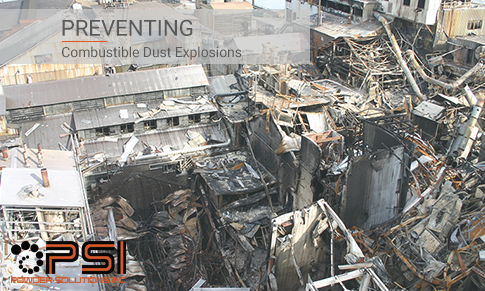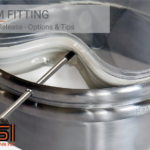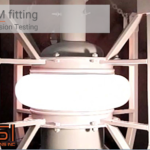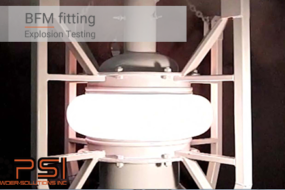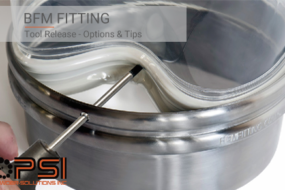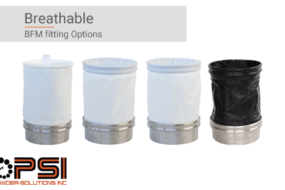Preventing Combustible Dust Explosions
It’s often surprising to learn that just about every product, including food, dyes, chemicals, and metals – even materials that you wouldn’t normally expect to be a fire risk in a solid-state – have the potential to become combustible in dust form.
Yet many staff in processing plants aren’t aware of just how dangerous dust can be. Just a thin layer of dust in a closed room is enough to trigger an explosion if the dust becomes airborne and is ignited by some form of heat, such as sparks from process equipment or electrostatic discharge (ESD).
In an industrial setting, a dust explosion risk is present wherever powdered materials escape the processing equipment and settle on horizontal surfaces, such as on the top of the machinery, roof support components, elevated ductwork and cable trays.
What are ‘secondary’ dust explosions?
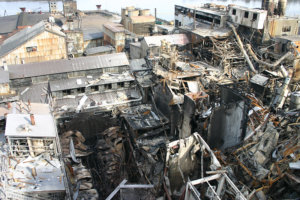
14 WORKERS WERE KILLED AND 38 INJURED IN THE INFAMOUS IMPERIAL SUGAR COMPANY PLANT DUST EXPLOSION AND FIRE IN THE USA IN 2008
If there is an explosion in your plant or equipment, and there’s dust sitting on surfaces outside the machinery, the shock of the primary explosion will cause that dust to become airborne. This dust cloud can then ignite, causing a secondary explosion.
These secondary explosions are often many times the size and severity of the primary explosion and, if enough dust has accumulated, they have the potential to bring down entire facilities, causing immense damage and fatalities.
How can you prevent combustible dust explosions?
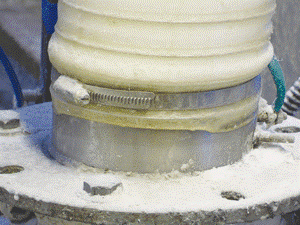
The number one priority is to reduce the amount of dust present outside of your processing equipment. The most common area where dust leakage occurs is at the transition points between process equipment, so ensure the flexible connections between your equipment contain your product 100% and that dust can’t escape.
Having a 100% seal is particularly challenging when using pneumatic transportation through your process, as the seal of traditional clamp-type connectors deteriorates significantly under higher pressures. If you do have dust leaking anywhere in your process, you must ensure it is cleaned up as soon as possible.
The second priority is reducing possible sources of ignition. Keep all machinery adequately maintained and cleaned to help prevent it from sparking during operation. Non-metal transitions between machinery where there is product flow, such as flexible connections, present a risk due to static electricity, which can build up and lead to arcing. Therefore, proper grounding practices and the use of static dissipative materials are highly recommended.
Contain any primary explosions that happen inside your equipment.
Containing any initial explosion to be entirely within the machinery must be a priority to ensure you reduce the risk of a serious fire, secondary explosions, and injury to staff.
Machinery with built-in explosion relief ports and panels are designed to channel flames and gases from an internal explosion up and out of the building to avoid any significant injury or damage on the ground. However, when there are multiple pieces of connected machinery in a process line, the weakest point for the potential escape of these explosive flames and gases is often at the transitions, or flexible connections, between machinery.
Traditional hose-clamped flexible connectors don’t tend to withstand these extreme forces, giving way quickly and allowing the explosion to propagate, potentially leading to a deadly secondary explosion.
BFM® fitting is the safer flexible connector of choice to reduce explosion risk.
Did you know there is currently, only one flexible connection system that provides a 100% sealed dust-free transition, will dissipate static electricity build-up and has been proven to resist explosions over 60kPa (8.7PSI, .6Bar). The BFM® fitting.
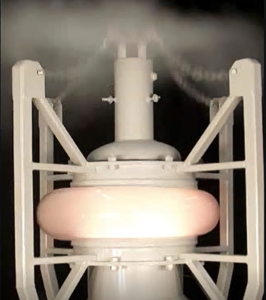
Because they seal from the inside under operational pressure, the flexible metal cuffs in the BFM® fitting connectors push outward against the inside of the spigot, tightening and improving the seal.
BFM®’s unique materials also provide proven1 static dissipation options, helping to prevent electrostatic build-up and arcing within the equipment, reducing the risk of a primary explosion. These anti-static properties, along with the unique connector design, give BFM® fitting’s product range preferential ATEX ratings, significantly reducing customers’ compliance risk and associated costs.
If an explosion does occur inside your process, the superior strength of BFM®’s materials and the snap-fit spigot system will help contain the explosive gases and flames within your machinery, reducing the risk of a secondary explosion.
BFM®’s popular Seeflex 040E fittings have undergone extensive testing2 and are proven to contain internal explosions in excess of 60kPa (8.7psi, .6Bar). In addition, to further reduce the risk of consequential fires, BFM® Kevlar covers have also been tested to withstand explosive pressures of more than 100kPa (14.5psi, 1Bar).
Major global manufacturers like AkzoNobel, Nestle, Unilever and Mondelez trust BFM® fitting to help keep their factories clean and reduce their combustible dust explosion risk.
- Undertaken by IBExU 2. Undertaken by Rocket Labs.
If you have any further questions about a BFM fitting sleeve or require a quote, please fill out the form below and we’ll connect with you in less than 24 hours.



